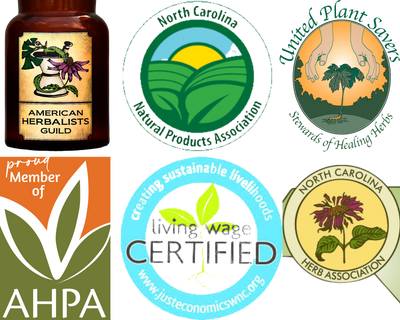Chaga (Inonotus obliquus) is a notably revered mushroom that could be mistaken for a hollow of a tree, a shadow, or even the leg or paw of a black bear if far enough away in a dim forest. The first time I saw chaga I didn’t recognize it as a mushroom at all. Now, if I turn my “wildcrafter’s vision” on, I can conjure a bit of a sixth sense that spies camouflaged chaga nestled in the tallest black birch trees. Almost always, I leave it there to keep right on growing, since chaga can take decades to reach full maturity and a chunk of chaga represents a chunk of time.
More akin to a hard black rock than a tender mushroom, chaga can’t be sliced, diced, or chewed. Its inner layers display beautiful variations of color from orange to terracotta, with an outer ebony edge. Chaga is a conk mushroom that famously grows on birch trees (Betula lenta) in the northern US, as well as northern regions of Europe and Asia. Because it is a parasitic fungus, it eventually kills the tree that hosts it after around 7-20 years, though some say that chaga only populates unhealthy or maimed trees that may have been already on their way out. Chaga appears almost to be a tumor on its tree, which gives thoughtful herb-lovers a clue to ponder as to one of its traditional uses in herbalism.

Sustainability Considerations with Chaga
The formation of chaga is a time-consuming process of between a few years and several decades, time that the average consumer has little patience for. While wildcrafted chaga must not necessarily be avoided altogether, the conscious consumer should take care to ensure that any wildcrafted chaga products are truly ethically sourced.
In 2022, United Plant Savers (an organization we deeply respect and partner with) announced that chaga was under review to be potentially included in their 'At-Risk' list of plants. Because of this and our commitment to true sustainability in herbalism, our chaga harvests take place under specific circumstances: we have done chaga "rescues," harvesting the woody conk from trees that were about to be felled, or we might harvest a very tiny percentage of the chaga that is growing in a prolific area where we know no other harvesters visit, monitoring the remaining chaga to ensure that it is left to continue growing.
We also advocate for the partial harvest option, and have seen the chaga sclerotium (not the fruiting body but a mass of mycelium formed of a corky orange interior) partially re-form in two years. If we just take a piece of the entire conk, we can return for several years or even a decade later to re-harvest. This is the beauty of coming into intimate relationship with one's terrain.
We never carve into a tree to harvest chaga as this hastens death for both entities, and we never harvest chaga once the tree is dead as the conk then goes into its reproductive cycle. Some friends who harvest sustainably have even seen a dying birch tree "bounce back" to life as long as the chaga taken from it is in very small amounts.
This slow rate of fruiting informs the sustainably-minded herb lover about potential ways to consume chaga in accordance with its gradual growth pattern: consuming chaga in a measured way, as needed, with respect for its rarity and patience for its power to come into maturity. Chaga is not the next mushroom superfood to sprinkle on your acai bowls and powder into your coffee. It is not an all-day, every-day type of weedy, abundant herb, but rather a heavy-hitting power mushroom to be used as and when necessary, with forethought and precise intention.
Chaga and the Immune System
Notice the header doesn't read “Chaga for the Immune System” because in general, we try to shy away from any one herb being ‘for’ any one condition, person, or body system. As much as we try to avoid that type of reductionist thinking, there is no doubt that chaga has the strongest affinity for the immune system and it is in the realm of immunity that its powers really shine.

Chaga's actions on the human body are multifaceted and complex. An adaptogen like many functional mushrooms, chaga meets the body where it is, uniquely adjusting to the needs of the particular individual, normalizing systems that are out of balance, and helping the body to respond to chronic stress in a healthy way. Chaga optimizes systemic health at the cellular level, supporting the body in activating cell death when appropriate, and providing the individual who is under extreme oxidative stress with welcomed antioxidants. Those who are severely deficient, profoundly depleted, and in need of deep nourishment and immunomodulation may benefit from chaga.
Heart and cardiovascular health are also deeply nourished by chaga, which supports the maintenance of a healthy blood sugar and cholesterol levels. Chaga has a long history of folk use in China and Russia for supporting a wide variety of health goals, from digestive aid to non-specific immune optimization.
How to Consume Chaga
For convenience, efficacy, and the greatest spectrum of benefit, the optimal method of chaga consumption is as a
double extraction of the mushroom. It is possible to consume chaga as a decoction, but keep in mind that you will not be able to access those important alcohol-soluble components of chaga that are present in a double extraction.

Processing chunks of chaga can be enough to dull the sharpest industrial Vitamix or break in the toughest mallet. Since chaga is such a precious resource, carefully considering the method of preparation and ingestion is imperative. A simple tea of chaga will not do its phytochemistry justice, nor will it penetrate deeply into the pores of its hard, rocky substance or break down the cell walls that house chaga's potent constituents. And don't be fooled by commercial supplements of powdered or processed chaga designed to be sprinkled on a smoothie or stirred into a latte. A long-simmered decoction will do this somewhat, but will fail to extract the alcohol-soluble components of the mushroom. A double extraction of chaga--a method which takes time--extracts both the water and alcohol-soluble constituents from the mushroom, resulting in a strong, well-rounded extract.
In respect for this harvest, we not only do the double extraction method but also save the extracted conk for making a later coffee substitute or for personal use in tea blends; for this use, we like to grind the softened chaga and re-simmer for the most benefit (and the grounds can be used over and over again in this way).
When to Use Chaga
Best harvested and consumed sparingly,
chaga is not your everyday "wellness" functional mushroom for immunity and stress-busting properties - for that, think of easily accessible and fairly abundant mushrooms such as
reishi,
turkey tail, shiitake, maitake, or a functional mushroom
blend.
In general, we
don't actually use chaga unless it is specifically indicated and really called for. Its potency is unmatched. Reserve it for those who need it the most. Don't think of it for run of the mill, daily immunity or use it to support conditions that more abundant plants like
echinacea,
elderberry,
usnea,
poke, or other
functional mushrooms could help with just as well. Chaga is a heavy-hitting conk to be used only with reverence and gravity in serious situations. This is one way we show respect to how long chaga takes to grow.
Reserving chaga for the deepest need and most dire or specific health situations protects the plant for those who will benefit from it the most. It is said that if you are choosy with your chaga usage, the reverence you have for this tough, powerful mushroom will come back to benefit you many times over.











Comments
Jennifer said:
Can Ghana tea be canned or frozen?
Heather Wood Buzzard said:
Ana and Robin, You’ll find info throughout this post on when chaga’s use is less appropriate:
“Chaga is not the next mushroom superfood to sprinkle on your acai bowls and powder into your coffee. It is not an all-day, every-day type of weedy, abundant herb, but rather a heavy-hitting power mushroom to be used as and when necessary, with forethought and precise intention.
Since chaga is such a precious resource, carefully considering the method of preparation and ingestion is imperative. A simple tea of chaga will not do its phytochemistry justice, nor will it penetrate deeply into the pores of its hard, rocky substance or break down the cell walls that house chaga’s potent constituents. And don’t be fooled by commercial supplements of powdered or processed chaga designed to be sprinkled on a smoothie or stirred into a latte.
In general, we don’t actually use chaga unless it is specifically indicated and really called for. Its potency is unmatched. Reserve it for those who need it the most. Don’t think of it for run of the mill, daily immunity or use it to support conditions that more abundant plants like echinacea, elderberry, usnea, poke, or other functional mushrooms could help with just as well. Chaga is a heavy-hitting conk to be used only with reverence and gravity in serious situations. This is one way we show respect to how long chaga takes to grow.
Reserving chaga for the deepest need and most dire or specific health situations protects the plant for those who will benefit from it the most. It is said that if you are choosy with your chaga usage, the reverence you have for this tough, powerful mushroom will come back to benefit you many times over."
Robin said:
Like Ana, I am also wondering about the “when not to” part.
Ana said:
When not to use Chaga? I didn’t see the information, thank you and have a great day.